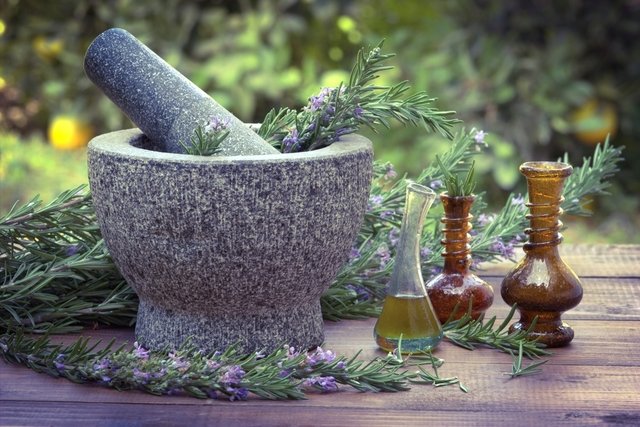Sitz baths for candidiasis, such as sodium bicarbonate or chamomile tea, have antifungal and antimicrobial action, preventing the excessive growth of the fungus that causes candidiasis, Candida albicans, and therefore help to alleviate the symptoms of candidiasis. irritation, itching, redness, swelling or discharge, for example.
Candidiasis is an infection caused by the excessive proliferation of the fungus of the genus Candida, mainly in the genital region, causing symptoms such as pain and burning when urinating or intense itching, but it can also occur in other parts of the body. Know how to identify the symptoms of candidiasis.
Although they cannot replace medical treatment, sitz baths are a good option for relieving the symptoms of candidiasis and can be used to complement the treatment recommended by your doctor.

1. Baking soda
The baking soda sitz bath helps combat candidiasis, because it reduces the acidity of the vagina, preventing the growth and proliferation of Candida albicans, relieving symptoms of the disease, such as itching and irritation.
Ingredients:
- 4 tablespoons of baking soda;
- 2 liters of warm boiled or filtered water.
Preparation mode:
Dilute the baking soda well in warm water and take a sitz bath by placing this solution in the bidet or in a basin. After performing intimate hygiene, sit and stay in contact with this water for 15 to 20 minutes. It is recommended to do this sitz bath twice a day, while symptoms persist.
2. Apple cider vinegar
Apple cider vinegar is another good option for making a sitz bath for candidiasis, as it contains lactic and gallic acid, compounds with antimicrobial and antifungal action that help alleviate the symptoms of itching, discharge, redness and swelling caused by candidiasis.
Ingredients:
- 4 tablespoons of apple cider vinegar;
- 2 liters of water.
Preparation mode:
Boil the water and, when it warms, dilute the apple cider vinegar. Place the mixture in a basin or bathtub. After performing intimate hygiene, sit down and take a sitz bath for 20 minutes once a day.
Non-use care: This sitz bath should not be used by pregnant women.
3. Tea tree essential oil
Melaleuca essential oil, also known as tea tree, has antifungal and antiseptic action and can be used in sitz baths to help reduce some symptoms of candidiasis, such as itching and burning. Discover other benefits of tea tree essential oil.
Ingredients:
- 5 drops of tea tree essential oil;
- 1 liter of warm water.
Preparation mode:
In a basin, dilute tea tree essential oil in warm water and, after intimate hygiene, take a sitz bath for 20 minutes once a day.
Non-use care: This sitz bath should not be used by pregnant women.
4. Barbatimão tea
Barbatimão is a plant rich in flavonoids and tannins, which are bioactive compounds with antifungal and astringent properties, and is therefore recommended to complement the treatment of candidiasis in sitz baths. Understand how barbatimão helps fight candidiasis.
Ingredients:
- 20g of dry barbatimão peels;
- 1 liter of water.
Preparation mode:
Place the water and barbatimão peels in a pan and boil for 15 minutes. Cover the pan and let it cool. Strain the tea and mix with a little more water to fill a basin. After performing intimate hygiene, sit in water for 20 minutes once a day.
Non-use care: This sitz bath should not be used by pregnant or breastfeeding women.
5. Chamomile tea
Chamomile tea contains flavonoids and essential oils with antifungal and antimicrobial action that help eliminate Candida albicans, relieving symptoms of itching, swelling, irritation or discomfort in the intimate region, making it a good sitz bath option to complement the treatment of candidiasis.
Ingredients:
- 3 tablespoons of dried chamomile leaves;
- 1 liter of water.
Preparation mode:
Boil the water and turn off the fire. Add the chamomile flowers to the water, cover the pan and let it rest for 10 minutes. Strain the infusion and transfer it to a basin. After intimate hygiene, take a sitz bath for 15 to 20 minutes, at least once a day.
6. Thyme and rosemary
The thyme and rosemary sitz bath is rich in antifungal substances, such as thymol, carvacrol and camphor, which act to prevent the multiplication of fungi, especially Candida albicans, helping to reduce discomfort and inflammation in the intimate region, making it a great option. of home remedy for candidiasis.
Ingredients:
- 1 liter of water;
- 2 teaspoons of dried thyme;
- 2 teaspoons of dried rosemary.
Preparation mode:
In a pan, bring the water to a boil and turn off the heat. Add the rosemary and thyme leaves, cover the pan and let it rest for 10 minutes. Strain the infusion and, after intimate hygiene, take a sitz bath, placing the mixture in a basin or bathtub, twice a day, until symptoms improve.
Non-use care: The rosemary sitz bath is not recommended for pregnant women and people with dermatitis or dermatoses.
Bibliography
- RAIMUNDO, S, Jéssica; TOLEDO, M, Cleyton Eduardo. Plants with antifungal activity in the treatment of candidiasis: a literature review. Uningá Magazine. Vol.29. 2.ed; 75-80, 2017
- FEDERAL UNIVERSITY OF SANTA CATARINA. HU/CCS medicinal plant teaching garden: Barbatimão (Stryphnodendron adstringens (Mart.) Coville). Available at: <https://hortodidatico.ufsc.br/barbatimao-stryphnodendron-adstringens-mart-coville-i/>. Accessed on April 4, 2022
- GOPAL, Judy et al. Authenticating apple cider vinegar’s home remedy claims: antibacterial, antifungal, antiviral properties and cytotoxicity aspect. Natural Product Research. Vol.33. 6.ed; 1-5, 2019
- SUS- CITY HALL OF CAMPINAS. Medicinal plants. 2018. Available at: <https://saude.campinas.sp.gov.br/saude/assist_farmaceutica/Cartilha_Plantas_Medicinais_Campinas.pdf>. Accessed on April 4, 2022
- KESSEL, Katherine Van; et al. Common Complementary and Alternative Therapies for Yeast Vaginitis and Bacterial Vaginosis: A Systematic Review. Obstetrical and Gynecological Survey. 58. 5; 351-358, 2003
- SAEIDI, Saeide; et al. Effects of Rosmarinus Officinalis Plant Extract on Trichomonas Vaginalis Parasites and Candida albicans under Laboratory Conditions: An Experimental Study. Gene Cell Tissue. 6. 3; e92867, 2019
- SEYEDJAVADI, Sima Sadat; et al. The Antifungal Peptide MCh-AMP1 Derived From Matricaria chamomilla Inhibits Candida albicans Growth via Inducing ROS Generation and Altering Fungal Cell Membrane Permeability. Front Microbiol. 10. 3150; 1-10, 2019
- OZEN, Betul; BASER, Muruvet. Vaginal Candidiasis Infection Treated Using Apple Cider Vinegar: A Case Report. Altern Ther Health Med. 23. 7; AT5751, 2017
- BOGAVAC, M.; et al. Alternative treatment of vaginal infections – in vitro antimicrobial and toxic effects of Coriandrum sativum L. and Thymus vulgaris L. essential oils. Applied Microbiology. 119. 3; 697-710, 2015

Sign up for our newsletter and stay up to date with exclusive news
that can transform your routine!
Warning: Undefined array key "title" in /home/storelat/public_html/wp-content/plugins/link-whisper-premium/templates/frontend/related-posts.php on line 12
Warning: Undefined array key "title_tag" in /home/storelat/public_html/wp-content/plugins/link-whisper-premium/templates/frontend/related-posts.php on line 13



